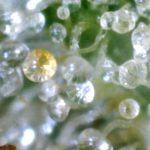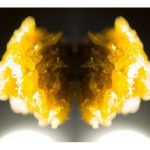What cannabinoids are in marijuana and what are they used for?
There are a number of receptors in our body, namely CB1 and CB2, that react to certain organic compounds called cannabinoids. In their natural form, some cannabinoids are innately produced by our own biochemistry and act on our endocannabinoid system, regulating physiological functions. Others, called phytocannabinoids, are found in abundance in Cannabis.
What are the cannabinoids in marijuana?
Although at least 66 cannabinoids have been discovered in cannabis, there are 4 that stand out especially for their abundance and their effects: THC, CBD, CBC and CBN. While the first three are synthesized thanks to enzymes from CBG, the last one is obtained thanks to a degradation process of THC itself.

Cannabinoids are concentrated in the trichomes of marijuana flowers and some are the result of the degradation of others. The proportion of each changes from strain to strain, but also as a result of factors such as climate, or especially UV rays, harvest time, etc.
Northern European varieties and conditions are said to favour strains with high levels of CBD, while towards the equator, in regions like Mexico or Iran, they are high in THC and low in CBD. And in areas of Indonesia or Nepal it is common to find more THC, but degraded and converted into another cannabinoid, THCV.
Although not all are psychoactive, these cannabinoids share a common trait: they have a variety of medicinal applications. And while there is still a lot of research to be done, the findings so far are a small sample of the high therapeutic potential of marijuana.
Let’s have a look, one by one, at the health benefits that can be obtained from these cannabinoids.
Medicinal uses of THC (Tetrahydrocannabinol)
THC is the most famous of all cannabinoids. It is responsible for the high, with great psychoactive potency. With a presence of 3% it already has a mild effect, which intensifies at higher proportions and becomes very powerful in strains with 20% or more.
THC is felt more in the brain than in the body, and is found in greater abundance in sativa strains. In addition to creating a sense of well-being, it sharpens the senses and stimulates creativity. But it also has enormous medicinal potential.
It serves as:
- It has a neuroprotective character, reducing the progression of degenerative processes and favouring neurogenesis.
- Antispasmodic, and reduces convulsions and epileptic seizures.
- Antidepressant and anxiolytic.
- Analgesic and anti-inflammatory.
- Anti-tumour and anti-metastatic, in some types of cancer.
- Antiemetic, to reduce nausea, especially for chemotherapy patients.
- Antioxidant, reducing free radicals.
In addition:
- Stimulates appetite.
- Bronchodilator effect.
- Used in cases of multiple sclerosis.
- Reduces eye pressure in cases of glaucoma.
- Helps to combat Crohm’s disease.
Therapeutic uses of CBD (Cannabidiol)
We could say that CBD is the most fashionable cannabinoid due to its medical potential. It is not usually very abundant in marijuana, although as a result of medical discoveries and thanks to genetic engineering, strains with percentages of up to 15% CBD are being obtained.
CBD is not psychoactive, and in fact acts by reducing the effect of THC. While THC has more of a mental effect, CBD acts mainly on the physical with a sedative effect. Indica strains tend to have higher concentrations of this cannabinoid.
The main therapeutic uses of CBD include:
- Antipsychotic, and is used to combat schizophrenia.
- Analgesic and anti-inflammatory, CBD is the most potent cannabinoid for pain relief.
- Muscle relaxant.
- Antibacterial.
- Anticonvulsant and antispasmodic, especially for people with epilepsy.
- Arterial hypotensive, and also helps to lower eye pressure.
- Anti-tumour and anti-metastatic.
- Antidepressant and anxiolytic.
- Antioxidant.
- Neuroprotective against Alzheimer’s degeneration.
- Antiemetic, to relieve nausea.
- Sleep inducer, for insomnia.
- Anti-ischaemic, to reduce the risk of arterial clogging.
- Bone growth stimulant.
It is also used to combat or alleviate the following diseases:
- Rheumatoid arthritis,
- Diabetes, as it lowers blood sugar levels.
- Gastrointestinal disorders: irritable bowel and Crohm’s disease,
- Psoriasis, and also acne.
Medical uses of CBC (Cannabichromene)
CBC is the great unknown among the cannabinoids, although the proportions of CBC are quite high compared to CBD. However, the therapeutic potential of this non-psychoactive element is gradually being discovered.
Among the main known benefits are:
- Strong antibacterial.
- Anti-inflammatory and analgesic, particularly effective against migraines.
- Stimulates bone growth.
- Antidepressant.
- Stimulates neurogenesis.
- Anti-tumour and anti-metastatic.
- Reduces insomnia.
- It has fungicidal properties.
Therapeutic applications of CBN (Cannabinol)
The cannabinoid CBN appears when THC is oxidised for a number of reasons generally linked to temperature, light and air, and in this degradation 90% of the psychoactivity is lost.
The main medicinal applications of this substance are:
- Anti-inflammatory and analgesic, more potent than THC.
- Antioxidante.
- Antispasmodic.
- Stimulates bone development.
- It can be used as an immunosuppressant, e.g. in cases of transplantation.
In addition to all these, science is discovering new benefits of marijuana and its active components on health every day with new studies.
If you found this article interesting, you can learn more about marijuana terpenes and their medicinal use.
Note: Natural Experience advocates responsible marijuana use and recalls that it is a subjective experience. This article has been documented with medical sources duly cited and written based on documentation reflected in studies. However, we are not medical practitioners and recommend that you consult a medical professional before deciding to apply cannabis use to any medical treatment.
Founder of Experiencia Natural, creative and entrepreneur, designer, master in grower and marketing. For a normalization of all plants and substances, giving priority to patients and users.












